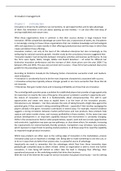Samenvatting
Summary book 'Managing Innovation' by Joe Tidd and John Bessant 2020
- Instelling
- Radboud Universiteit Nijmegen (RU)
- Boek
- Managing Innovation
Samenvatting van het boek 'Managing Innovation' geschreven door Joe Tidd en John Bessant. Alle hoofdstukken zijn samengevat. De hoofdstukken die niet verplicht zijn om te lezen zijn wat korter samengevat dan de hoofdstukken die uitgevraagd worden op het tentamen (hoofdstuk 7 en 9 minimaal samengeva...
[Meer zien]





